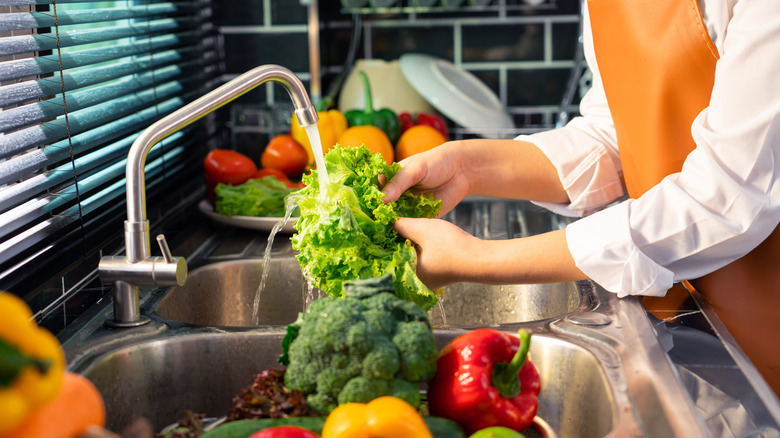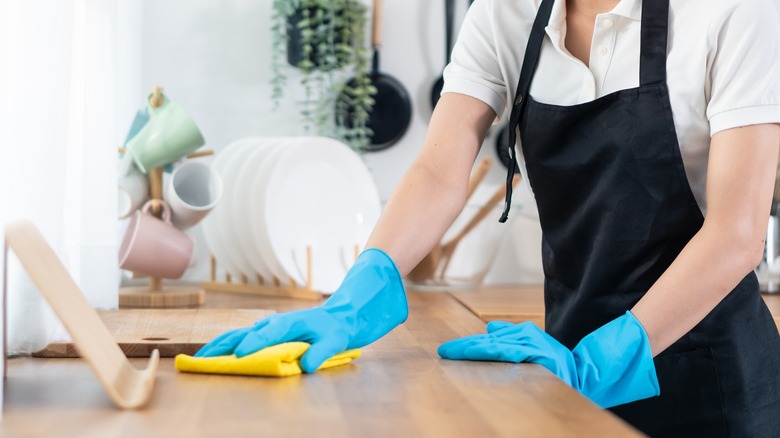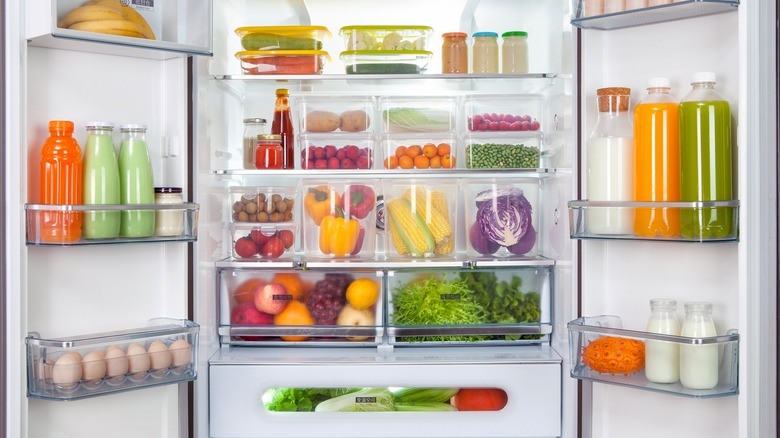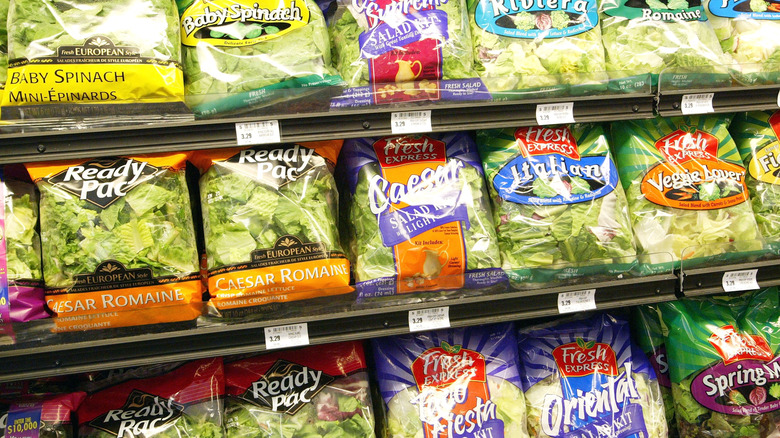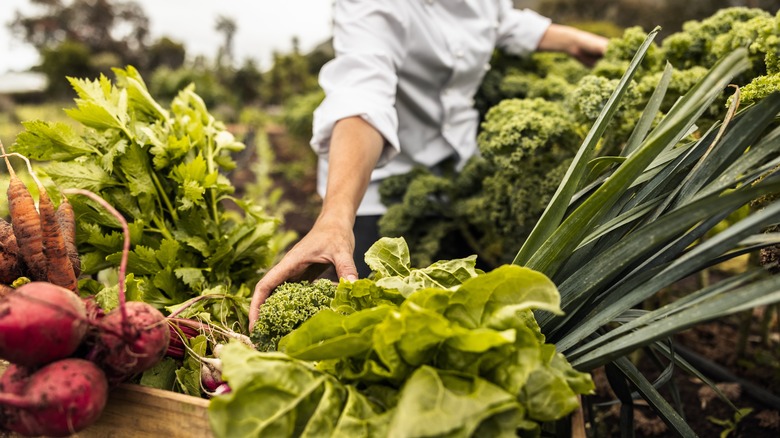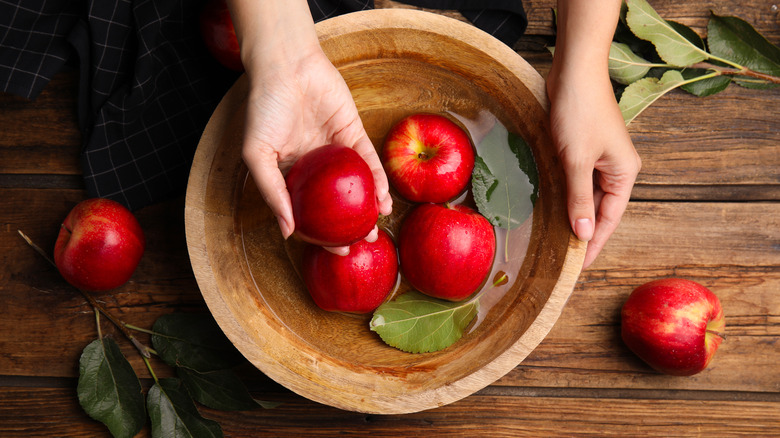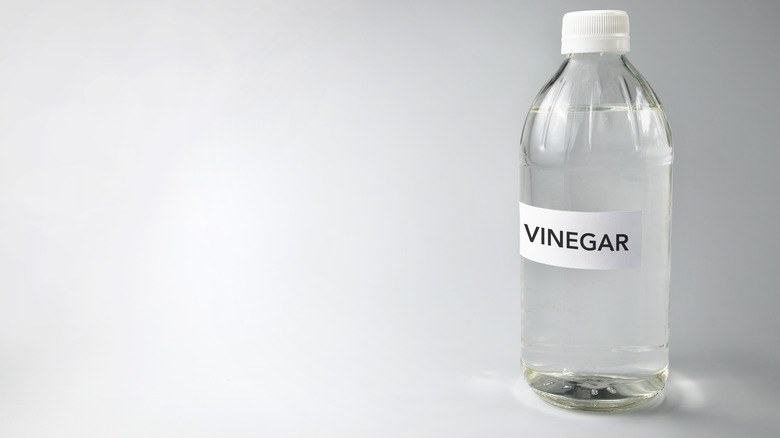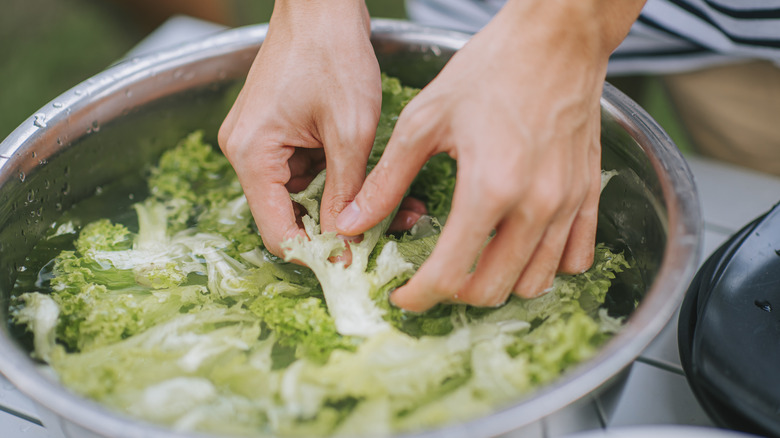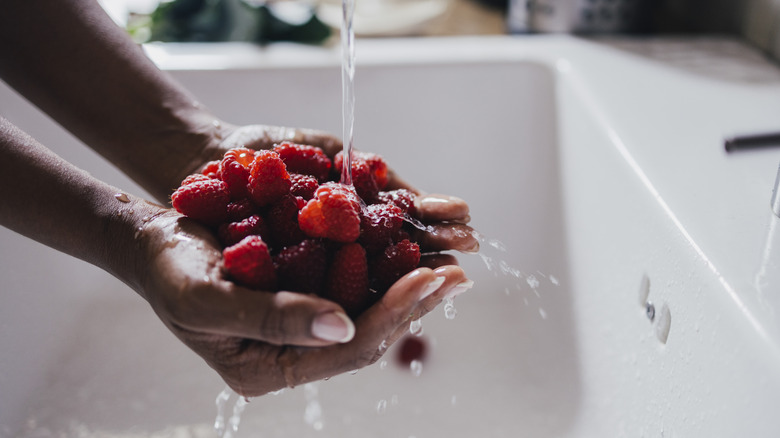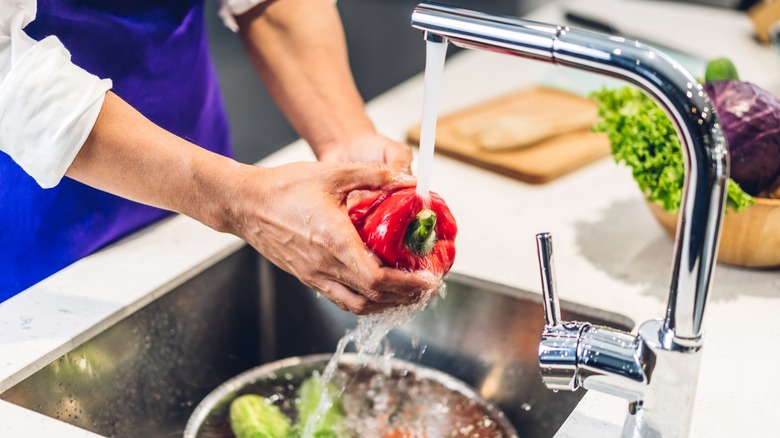What You Need To Know About Washing Fruits And Veggies
When it comes to kitchen prep, everyone worries about whether or not the food they're serving is really, really clean. Unfortunately, washing produce can be a little intimidating. You don't know where your food has been, after all, and you don't know what it's been through before you picked it up in the grocery store or off the stall at the farmers' market.
Let's look at everything you need to know about washing your produce, no matter where it came from, and some ways to help you make sure you're keeping your family safe.
Clean your work surface first
It's incredibly easy to overlook, but according to the guidelines from The University of Maine, you should always give your work area a quick once-over at a specific point in your prep process. The university recommends making sure you wash your work surface completely between peeling off any outer skins and cutting or slicing up the veggies into their final form. Failure to do so can lead to the transfer of bacteria.
While you probably keep your utensils, knives, and peelers all clean, you should also know that slicing through fruits and veg can transfer bacteria from the skin into the meat of the fruit. The best way to prep not just your cutting board but your counter, too, is to wash the entire area with hot water and soap before you start cutting. (Cleaning your work area also includes washing your hands, first, for at least 20 seconds with warm water and soap!)
Why you should wait to wash
Washing your fruits and veggies is all done to stop the spread of bacteria and to get rid of any unwanted residue that's left behind from the growing process, so there's probably a certain school of thought that says you don't want any of that dirt or bacteria in your fridge, either. But if you're tempted to wash your produce right when you get it home, you should wait.
Washing your produce before storing it can actually do more harm than good, according to Colorado State University. Not only can the dampness create the perfect environment for bacteria to grow, but it's also going to speed up the process in which your food goes bad. In most cases, fruits and vegetables have been prepped for grocery store or farmers' market presentation, and that means they're free of the majority of the dirt and have at least been given a cursory wash. Therefore, in order to keep your produce at its freshest for the longest amount of time, you should wait until right before you're going to use it to wash it. If you absolutely can't bear to have dirty produce in your kitchen, be sure to dry it thoroughly before putting it away — but remember that you can only get produce so dry.
Washing pre-washed salads and lettuce
Bagged salads are great, especially if you need something quick and nutritious to grab for your lunch on the way out the door, as you're scrambling to fit your morning routine into what's never enough time. Most pre-made salads are labeled as triple-washed or ready to eat, but no one's going to blame you if you're reserving a certain amount of suspicion as to just how clean these pre-made salads are, especially in light of the occasional news story about some pretty horrible things being found in them. But this is one time you can skip washing your produce. According to the FDA, re-washing isn't only unnecessary, but you might be exposing your food to more potential contaminants by trying to re-wash these ready-to-eat products.
Foods that are labeled as ready-to-eat are usually produced in a way that involves being washed by commercial-grade equipment, and they're prepared and packaged in facilities that are regulated by authorities who have been approved to make sure they're safe and sanitary. Studies done specifically to find out whether or not re-washing was needed have concluded that not only is it unnecessary, but that consumers have a high potential to cross-contaminate the produce or expose it to bacteria on surfaces like sinks. Your best bet is the simplest one, and that's just to dump the salad into your bowl without even touching it.
Why you need to wash organic produce
Organic produce has a reputation of being safer and more nutritious, but if you're familiar with the regulations that govern organic produce and the methods used to grow it, you know that pesticides can still be used on these trendy pieces of fruit and veggies. Organic produce can also be exposed to bacteria that can very possibly make you sick, and in that respect, it's no better or worse than traditionally grown produce.
Additionally, being organic does not mean the produce is not exposed to the elements; bugs, animals, and soil; and potential contaminants in the shipping and handling phase of its life, so you still should wash it.
What's the deal with produce washes?
It's likely you've seen fruit and vegetable wash at your local grocery store. There are a number of these products available, and if you're asking whether or not they do better than regular or distilled water, you're not the only one with these questions.
The Department of Food Science and Human Nutrition at the University of Maine took a look at just how well some of these produce washes are at what they claim to do, and whether or not they are better at getting rid of the bacteria linked to causing illness than other washing methods. Researchers found that, while the produce washes generally do what they advertise, they have just as much success getting rid of bacteria and microbes as distilled water does. And when it comes to ozone produce washes, they work less well compared to a water bath. Save yourself some cash, and give the produce washes a pass!
Home-grown wash solutions
If you're still doubtful that just plain tap water or distilled water is going to be tough enough to get all those germs and bacteria off your fresh produce, there are a couple of other things you could try.
For your tough-to-wash leafy greens and for produce that has a ton of cracks and crevices (like broccoli or cauliflower), you might want to consider using a vinegar solution. The ratio is half a cup of distilled white vinegar, cider vinegar, rice vinegar, or lemon juice to two cups of water. Produce can be sprayed with the solution or dipped into it, but you should also know that even rinsing thoroughly after doing so might not get rid of the taste of the vinegar entirely, and it might slightly change the texture of your produce, too. While vinegar has been found to be particularly effective against salmonella, another commonly used kitchen disinfectant, baking soda, isn't going to get your produce any cleaner than just plain old water, so don't bother adding the powder to your DIY produce wash.
Getting those leafy greens clean
Now, let's talk about some specifics when it comes to some of the most challenging types of produce to wash: leafy greens. The difficulty comes from the fact that dirt and grit can collect in all the crevices and creases of the leaves, and if you can see those granules, what does that mean for bacteria?
To get these completely clean, break apart the leaves and submerge them in a basin of water. Swish them around a bit to help dislodge the grit, then let them sit for a few minutes so the dirt settles to the bottom. Take the leaves out, but don't pick up the basin or you'll disturb the sediment. If there's a ton of dirt that comes off the greens, repeat the process with a clean bowl of water until you're seeing little to no grit coming out. Dry them with a salad spinner if they're going to be headed into something you're going to eat raw, or feel free to cook your greens when they're still a little damp.
Washing delicate fruits like berries
When it comes to berries, you might be tempted to soak them, too. But there's a better way, and that's just putting them in a colander and rinsing them under running water. You probably know how easy berries are to damage, and this is a simple method that's not only going to keep them clean, but it's going to keep them from turning to mush.
There are few kitchen disasters more heartbreaking than looking forward to a bowl of freshly picked strawberries or raspberries, only to have them fall apart when you're washing them. Room-temperature berries can be so soft they're tough to wash, but if you pop them in the fridge for an hour or so before you do wash them, you'll find that they've firmed up just enough to be able to hold their shape better under the force of running water. You'll end up with berries that aren't just clean, but whole and perfect for putting on top of cereal, that cake you're baking, or eating by the handful.
Some general group guidelines
While there are a ton of different types of produce you might be bringing home and there's not enough room to talk about them all individually, there are some general guidelines you can use to apply to pretty much anything you're going to be washing and eating.
Pick up a produce brush: Use it on things that have a tough outer rind like melons and mangoes because you want to get off as much dirt and bacteria as you can before you cut off the rind or cut through it. You can use the brush on produce with more delicate skin, too, like apples and peppers, to get those squeaky clean as well.
Always wash before cutting, and if there's an outer layer to the produce (think Brussels sprouts), your best bet is to remove those layers before you wash. For vegetables with a stem (like peppers), you want to remove that after you've washed it.
For smooth produce, the general rule is to rinse, scrub for five seconds, and re-rinse. For produce with trickier bits (think asparagus, broccoli, and spinach), the general rule is to let them soak for two minutes, then rinse off the loosened particles for 15 seconds. Keep those in mind, and you'll be going a long way to making sure your produce is as clean as it possibly can be!
